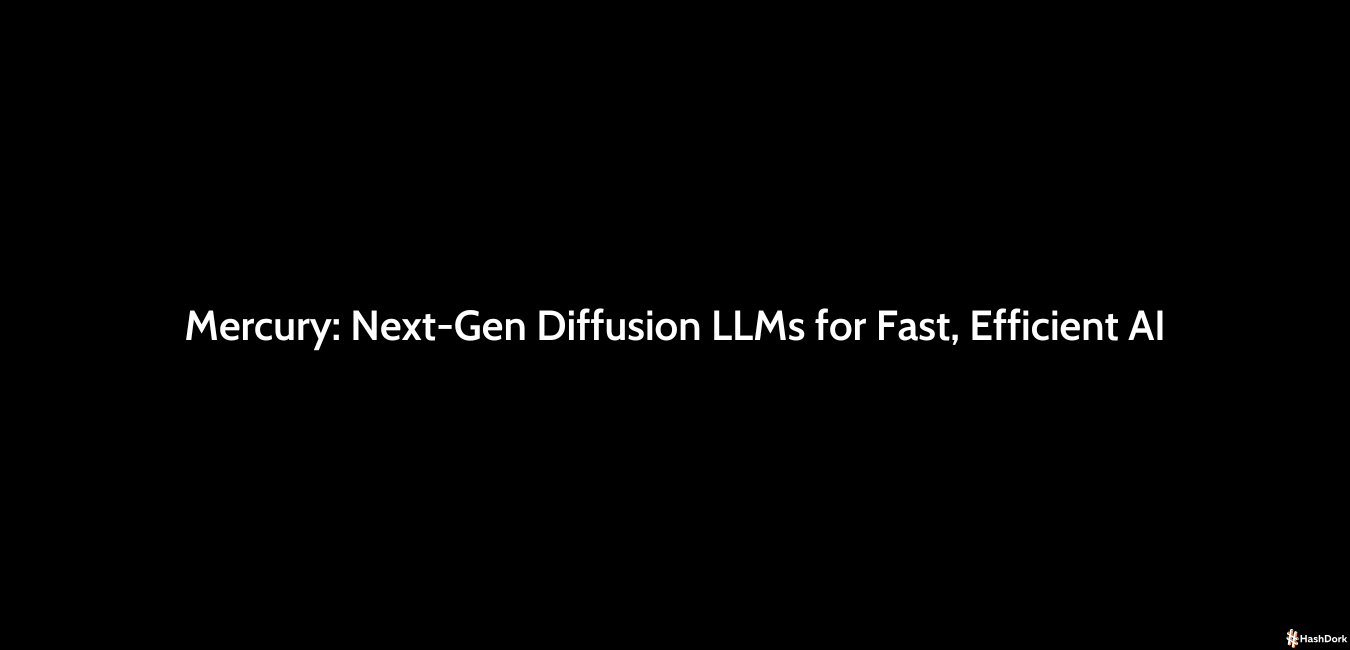Table of Contents[Hide][Show]
Is there a faster, more efficient way to generate text or code? Yes, now we have diffusion-based large language models.
But how is it different from traditional large language models?
Traditional LLMs (large language models) are autoregressive. They generate text one token at a time, with each phase being dependent upon the previous one. This process is sequential and can be sluggish, as it does not allow for the revision of previously established tokens.
On the other hand, diffusion-based models begin with an initial draft of the entire text and refine it over a series of actions. This approach helps them to change any element of the text during creation, which leads to more accurate and strong outputs.
Traditional LLMs have various challenges:
- Latency: The process of generating text token by token can be time-consuming, resulting in delays.
- Cost: Operating costs are raised by the computational resources needed for sequential processing.
- Error Propagation: The quality of the final product can be influenced by errors that occur during the initial stages of the generation process.
These problems draw attention to the requirement of a fresh approach to text production.
But where can we use diffusion-based LLMs?
Mercury is the first commercial-scale diffusion large language model developed by Inception Labs. It was developed to overcome the limitations of conventional LLMs by providing:
- Speed: Produces text up to 10 times faster than current models.
- Efficiency: Significantly decreases operational expenses.
- Quality: Generates text that is both accurate and cogent, and includes an integrated error correction system.
Mercury does this by iteratively improving text outputs, which allows changes at any stage of creation.
Mercury’s release is a turning point in the field of AI evolution. It challenges the dominance of autoregressive models and provides a viable alternative that is superior in quality, efficiency, and speed by using a diffusion-based approach.
This development sets a new benchmark in the sector and creates new opportunities for applications needing fast and consistent text and code generation.
Interested to see how diffusion-based LLM (Mercury) could improve your project?
Then continue to explore the post.
Wait, did I explain Diffusion models?
Generative AI has been transformed by diffusion models, which have introduced a novel coarse-to-fine technique for content creation. Diffusion models start with a noisy version of the intended output and iteratively improve it to get clear and coherent outcomes, unlike conventional models that generate data sequentially.
The model can modify and enhance the entire output simultaneously by beginning with random noise and progressively denoising it.
This method has been particularly effective in the creation of images and videos. Diffusion techniques are used by platforms such as Midjourney to generate detailed images from textual descriptions, while OpenAI’s Sora uses similar methods to produce high-quality videos in response to user input.
These applications show the adaptability and efficacy of diffusion models in managing complex generative tasks across various media formats.
Transitioning Diffusion Models to Text Generation
Diffusion models face some challenges when used for text generation because of the discrete character of language data:
- Discrete Tokens: Text is made up of discrete tokens (words or characters), in comparison to pictures or videos, which affects the ongoing diffusion model improvement process.
- Sequential Dependency: The meaning of a sentence can be changed by the rearrangement of elements, as language is significantly dependent on the order of words. It is a complex task to ensure that diffusion models maintain sequences that are contextually accurate and coherent.
- Error Propagation: In the process of text generation, the intended meaning can be significantly affected by minor errors, requiring that models contain precise control over the selection and arrangement of tokens.
The complexity of language generation requires innovative adaptations of diffusion techniques to effectively address these challenges.
Mercury Developed by Inception Labs
Mercury is the first commercial-scale diffusion large language model (dLLM), and Inception Labs has made substantial progress in addressing these challenges through its development.
Its text generation process is based on diffusion, which involves the parallel refinement of entire sequences rather than the production of a single token at a time.

This method resolves the latency and error propagation issues that are prevalent in conventional autoregressive models, enabling the generation of text that is both more solid and quick.
The architecture of Mercury allows it to dynamically rectify errors during the generation process, which increases the overall quality and reliability of the output. Inception Labs has set a new standard in the field by combining diffusion methods with language modeling to make AI-driven text creation faster and more accurate.
Here are some key features of Mercury:
- Speed: Increases productivity by producing text at a rate that is 5 to 10 times quicker than that of conventional LLMs.
- Efficiency: Operates at a cost that is 5 to 10 times lower than that of conventional models, which improves its accessibility.
- Quality: Maintains high performance without increased latency or expense, producing outputs that are comparable to models twice its size.
- Advanced Reasoning: Enhances reliability by incorporating built-in error correction to reduce hallucinations and address errors.
- Multimodal Capabilities: Offers a unified AI solution by excelling across a variety of data categories, such as text, images, and videos.
- Enhanced Control: Provides precise management of output structures, making it an ideal choice for tasks such as structured data generation and function calling.
These capabilities establish Mercury as a tool that is both efficient and adaptable for a wide range of AI applications.
The Blueprint of Mercury
Architecture and Design
Mercury integrates diffusion processes into its architecture, which represents a substantial improvement in large language models. Conventional autoregressive models predict one token at a time based on the previous context, producing text in a sequential manner.
But Mercury uses a diffusion-based method instead, starting with a rough estimate of the whole text sequence and improving it over and over again. This approach increases speed and consistency by letting all tokens be simultaneously created and adjusted.
Important architectural details include:
- Parallel Token production: Mercury speeds up text production and lowers latency by processing several tokens at once.
- Iterative Refinement: The model enhances the overall quality and consistency of the text output by refining it through successive denoising steps.
- Improved Contextual Understanding: The diffusion process allows the model to take into account the global context during generation, resulting in outputs that are more contextually useful.
These developments define Mercury as a flexible and effective tool for a range of AI applications.
Performance
Mercury’s performance has been carefully compared to other systems to prove how fast and efficiently it works. Mercury is capable of producing more than 1,000 tokens per second on NVIDIA H100 GPUs, according to independent evaluations. This is an extraordinary accomplishment in the realm of large language models.

This performance results in a 5-10x speed advantage over current models, which substantially reduces computational costs and latency.
Performance benchmarks consist of:
- Token Generation Speed: On NVIDIA H100 GPUs, the rate of token generation exceeds 1,000 tokens per second.
- Cost Efficiency: Provides access to a wider variety of applications by operating at a fraction of the cost of conventional models.
- Scalability: Ensures adaptability to a variety of operational environments by maintaining high performance across a variety of hardware configurations for operations.
Mercury’s ability to produce high-quality results quickly and cheaply is shown by these measures.
Error Correction and Reasoning
Mercury stands out for its strong reasoning capacity and error corrective power. The model can revisit and refine any aspect of the text during generation as a result of the diffusion-based architecture, which effectively reduces inaccuracies and hallucinations. This iterative refinement process ensures that errors are detected and rectified in real time, resulting in outputs that are more consistent and dependable. Important features include:
- Dynamic Error Correction: The model continuously evaluates and rectifies inaccuracies during the generation process.
- Enhanced Reasoning: The non-sequential nature of diffusion models allows for a comprehensive understanding of the text, which enhances contextual relevance and logical consistency.
- Reduced Hallucinations: Mercury reduces the incidence of fabricated or irrelevant information by enabling modifications at any generation stage.
Together, these characteristics make the model more reliable, which makes it useful for tasks that need to generate text that is accurate and makes sense.
Technical Deep Dive
Training Paradigms
Mercury uses a diffusion approach to train its language model. The model learns by continuously refining text outputs from random noise through a series of denoising steps. It begins with lots of raw text data that has been tokenized and carefully cleaned.
Data from the training process feeds a Transformer network guiding every stage of noise reduction. Particular preprocessing techniques change the token distribution to fit the diffusion technique.
The network acquires the ability to produce text by iteratively rectifying its output until it fits with the anticipated language patterns. At regular stages, progress is tracked, and learning rates are changed based on how many mistakes were made.
Also, parallel data processing is used to manage substantial data inputs during the training procedure. At last, the method combines feedback loops that, with every training cycle, raise text quality.
Mercury can be seamlessly integrated into existing infrastructures by developers with minimal modifications. This method keeps costs low while making text generation jobs very fast.
Inference Process
Mercury generates text during inference by following a sequential pipeline. Starting the generating process with an input prompt, it adds random noise. The model then uses a set of denoising techniques to translate noise into an understandable answer.
Rather than analyzing one token at a time, the Transformer network assesses the whole sequence at every stage. This approach lets the model simultaneously change many tokens. Built-in error correction lets the model repair any errors during every pass.
The pipeline optimizes token generation through the implementation of effective memory management and parallel processing. While maintaining a high rate of speed, each denoising cycle enhances understanding and accuracy. The procedure ends when the text output fits the input prompt and passes quality tests.
Application of Mercury
Code Generation
Mercury Coder, a diffusion-based large language model (dLLM) that is expressly configured for code generation tasks, has been introduced by Inception Labs.

It uses a coarse-to-fine approach, refining entire code blocks in parallel, in contrast to conventional autoregressive models that generate code token by token.
This method considerably accelerates code generation, attaining speeds that are up to 10 times faster than conventional models. On NVIDIA H100 GPUs, the throughput exceeds 1,000 tokens per second.
Performance Highlights:
Benchmark Achievements: Mercury Coder consistently outperforms speed-optimized models such as GPT-4o Mini and Claude 3.5 Haiku on standard coding benchmarks. For example, Mercury Coder Mini gets an 88.0 on the HumanEval test, which is higher than both GPT-4o Mini’s 88.0 and Claude 3.5 Haiku’s 86.0.

Efficiency: Mercury Coder Mini operates at a rate of 1,109 tokens per second, which is considerably higher than the 59 tokens per second of GPT-4o Mini and the 61 tokens per second of Claude 3.5 Haiku.

Integration Options:
API Access: Mercury Coder’s robust API enables developers to seamlessly integrate Mercury Coder into their operations, which allows the efficient generation of code in a variety of applications.
On-Premise Deployment: Mercury Coder has options for on-premise deployment for companies that put data protection and control first. This makes sure that they follow their own rules and policies.
Mercury Coder is a useful tool for developers looking for dependable and quick coding solutions as it not only increases correctness but also the speed of code development by using diffusion techniques.
Future Prospects
Diffusion language models (dLLMs) are about to change the way large language models (LLMs) work by adding a number of new features, such as:
- Enhance Agents: The rapid processing and efficacy of dLLMs render them optimal for applications that necessitate extensive planning and long content generation, such as real-time decision-making systems and complex simulations.
- Advanced Reasoning: dLLMs can fix mistakes quickly and fast using internal reflection, which helps to lower hallucinations. This development makes it possible to solve difficult problems in seconds, a major improvement over existing approaches that can require long processing periods.
- Controllable Generation: The architecture of dLLMs enables the altering of outputs and the generation of tokens in a variety of flexible sequences. This tool lets users create information following specified formats, align outputs with certain goals like safety procedures, and fill text.
- Edge Applications: dLLMs are well-suited for deployment in resource-constrained environments, such as mobile devices and laptops, to enable sophisticated AI functionalities without the need for extensive computational resources, due to their efficiency.
The integration of diffusion models into LLMs represents a paradigm shift that improves the speed, accuracy, and versatility of various applications. This technology is expected to open up new possibilities in AI-based tasks, such as more complex thinking and collaborative systems that work in real time.
Conclusion
Mercury has revolutionized AI technology in 2025 by introducing the first commercial-scale diffusion large language model (dLLM). On standard hardware, this innovation achieves over 1,000 tokens per second, which is up to 10 times quicker than traditional models for text generation.
Mercury’s diffuse-based technique improves both speed and quality via simultaneous refining of whole text sequences. This approach enables constant improvement, which allows the model to efficiently rectify mistakes and lower errors.
It offers a more accurate and effective answer for challenging linguistic problems by tackling the limits of autoregressive models. This development is especially helpful in applications that require extensive planning and long content generation, such as interactive systems and real-time simulations.
It’s design also offers token creation and flexible output editing, therefore enabling users to personalize outputs to fit certain goals and forms. In short, Mercury’s diffusion-based models provide a transformative solution to the obstacles encountered by AI applications in 2025, resulting in improved performance, efficiency, and adaptability.







Leave a Reply